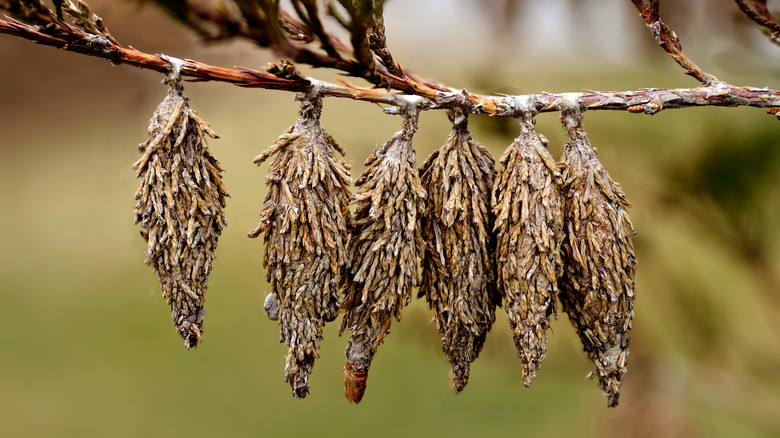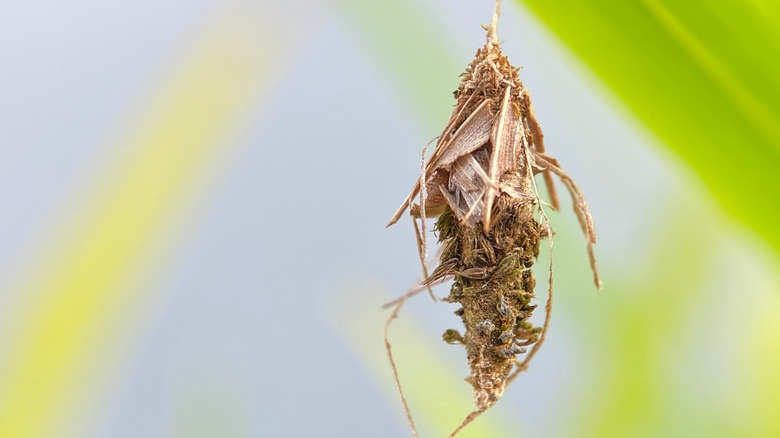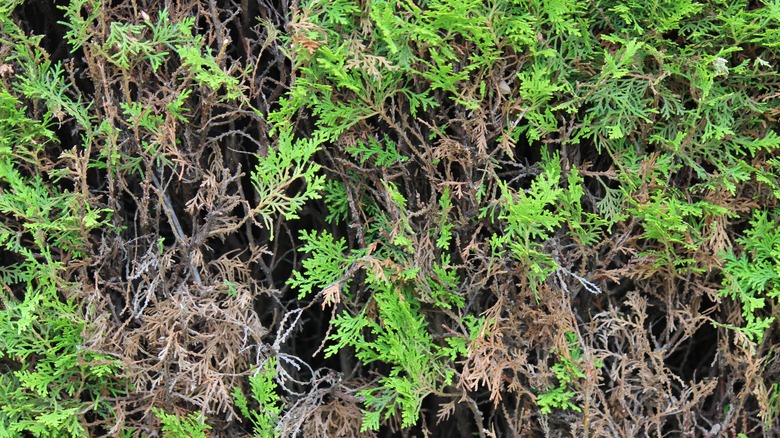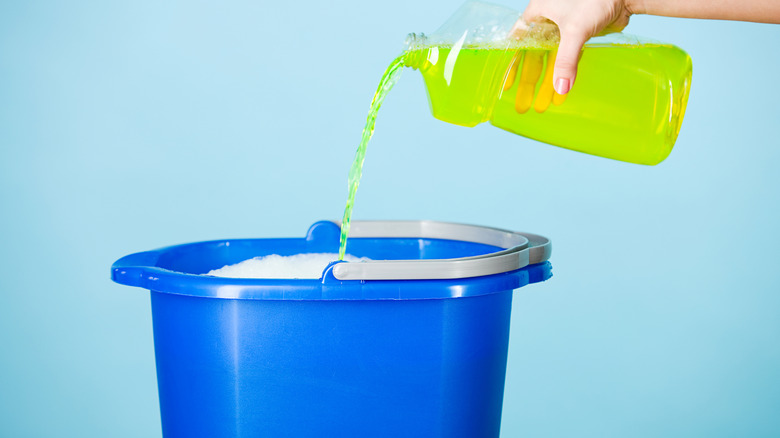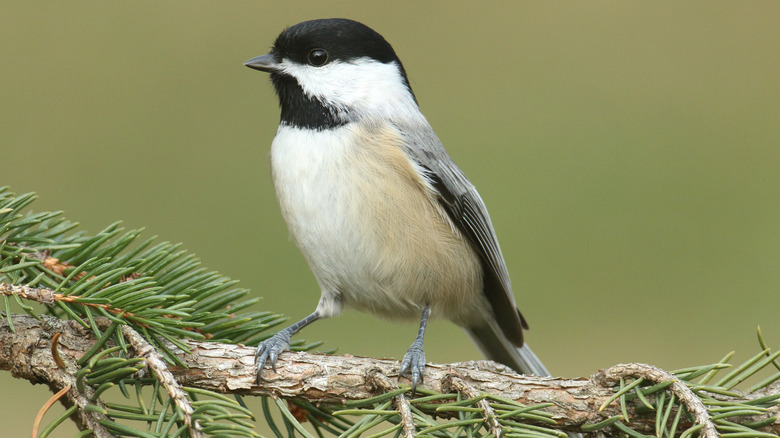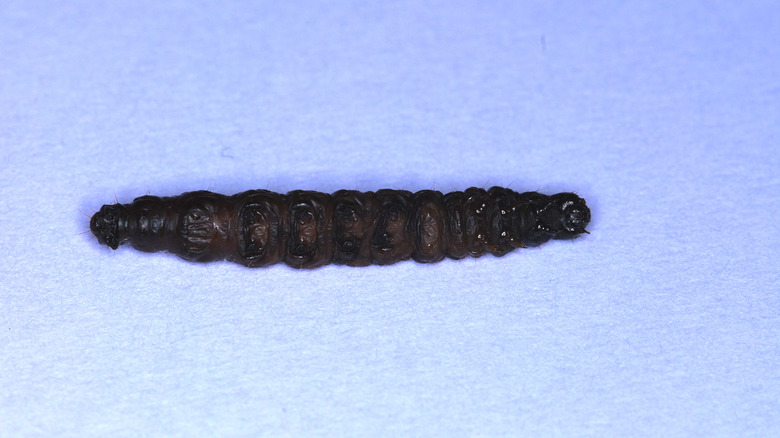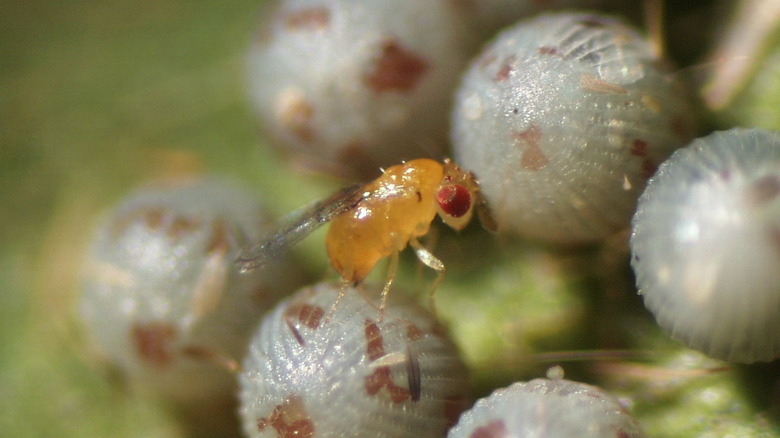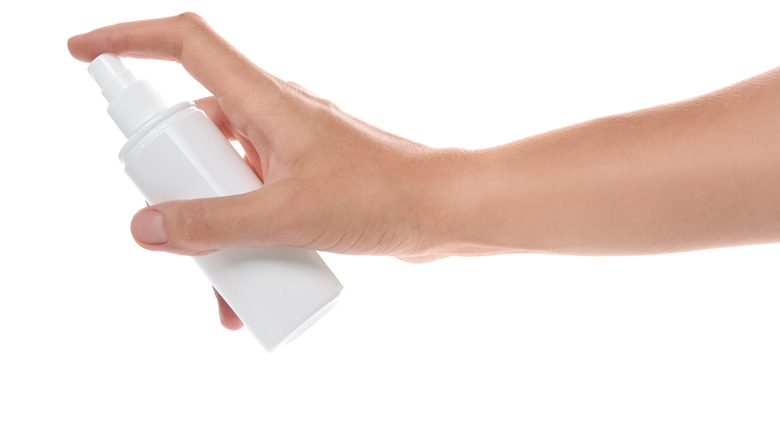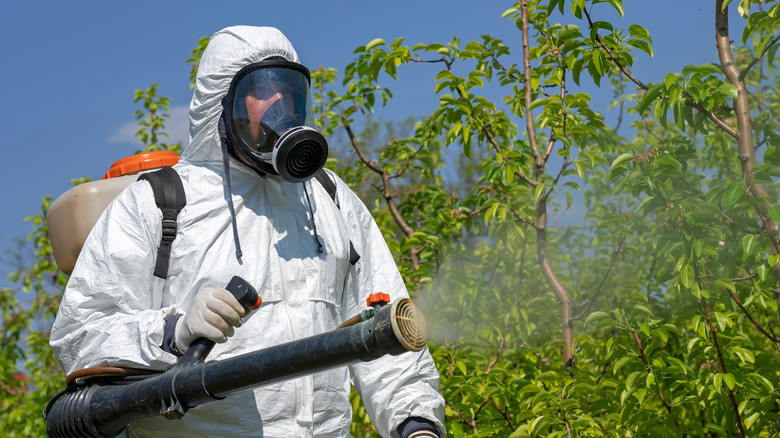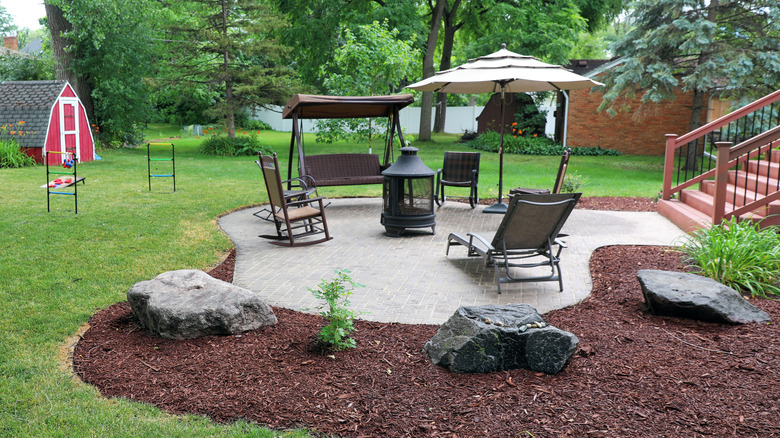How To Get Rid Of Bagworms: 10 Ways That Work
Unlike crickets that deprive you of a good night's rest and the rather elusive spider mites that can ruin an entire plant before you know it, bagworms are seasonal invaders that target mainly coniferous trees (and some shrubs). And you might almost mistake their hanging, silky homes for pine cones. Despite their rather interesting appearance, bagworms can pose a real threat to the trees they inhabit — potentially defoliating them (causing them to lose all of their leaves) or even completely killing them.
During their mating period, the adult bagworms become resilient, out of sight, and almost impossible to kill. Both genders stop feeding altogether. The female stays enclosed in the sealed, protective bag laying eggs for four weeks while the male naturally dies two days after mating. Now, if you notice the evergreens on your landscape turning brown or losing needles or you catch any other signs of an infestation, keep reading to discover proven ways to get rid of them.
What are bagworms?
Despite their name, bagworms are not actually worms. They are really caterpillars that live inside a "bag," or cocoon spun from silk. These pests strengthen their cocoons using various materials found in nature, such as leaves, pine needles, and twigs.
Bagworm larvae hatch from one of these hanging homes in the spring, typically towards the end of April or the beginning of May. Once they emerge, these caterpillars begin feasting on tree branches. They'll also start forming their cocoons right after hatching from the eggs. Metamorphosis occurs inside the cocoon during August, which is followed by the adult males emerging a few weeks later. They then fly off to find one of the females — who do not have wings and remain inside the "bag" — to mate with. Once she's mated, the female will lay her eggs (hundreds of them) inside her cocoon before dropping out of the bag and dying.
Bagworms are part of the Psychidae family. In all, there are more than 1,300 different species across the world. These pests prefer pine, cedar, juniper, and other coniferous trees, though they can also be found on maple, linden, and other deciduous trees. However, they'll cause the greatest damage to conifers, potentially defoliating or even killing them.
Signs of a bagworm infestation
There are several signs to look out for that can indicate the presence of a bagworm infestation. If you notice some lighter patches on the needles or leaves of the tree, it may mean that the pests are present. Noticing this discoloration is typically an early sign, as when the infestation has become bad, the tree may lose a significant amount or even all of its foliage. Bagworms may also leave holes in the leaves of a deciduous tree or cause the tips of the branch to die.
If you take a close look at the tree, you may be able to spot the bagworms themselves, which would obviously be a clear sign of an infestation. Remember, they form bag-like cocoons which may resemble a pine cone. You're more likely to actually spot these in the late summer, as this is when they've finished forming these structures.
1. Handpick and drop bagworms in soapy water
Whether you have a mass invasion to handle or those creepy plants-mongering moths are just beginning to find their ways to your yard and you'd rather eliminate them from eggs to adults (all of them), put on your protective hand gloves, prepare a bucket of warm or hot dish soapy water, and ... let's get to work!
Wait, will dish soap kill bagworms? Really? Well, yes. Just like the whiteflies that invade your garden, bagworms are defenseless to soap. The chemical composition of dish soap infiltrates the protective wax coat of larvae insects, drains their vital fluids, messes up the metabolism of their cells, and ultimately kills them. Unfortunately, as confirmed by Garden Myths, soap is equally damaging to your plants and bagworm bags can be impenetrable to liquid soap. That's why Home Guides suggests handpicking the bags, cracking them open to make the inhabiting insects vulnerable, and dropping them in a bucket of warm or hot soapy water for hours to die. Take note, this technique promises a higher success rate in autumn and winter when the bags naturally drop off from all the hanging spots, especially from the hidden branches which you would have missed.
2. Introduce predatory birds
Prevention is better than the cure (argh... clichés, everywhere). Now, even after treating your yard for a bagworm infestation, your neighbor probably didn't, and those larvae can easily ride on the wind back to you from an external host. So, what gives? Well, Yardner suggests that inviting bagworm-preying birds who have young ones to feed in June (aka winter birds) is not just a way to get rid of existing bagworms, but also an establishment of natural defense against a potential invasion. Titmice, chickadees, and nuthatches are the most voracious predator birds for bagworms, and because a female adult bagworm lays between 300 to 1000 eggs in a season, it's important to start this process early (as discussed below). That way you invite as many as possible predator birds before June, when the hatched eggs leave their protective bags to feed and the adult larvae repair and build more bags.
This method is pretty easy, potent, and the process is fun to watch, as described by Annapolis Native Landscape; you plant trees (deciduous trees and broadleaf evergreens) and shrubs that provide direct shelter and feed to these birds, encourage them to hang around your yard with feed in bird feeders and water in birdbaths, and then simply wait and watch the predator birds work for you.
3. Apply Bagworms-Killing Bacteria
Some micro bacteria that feed on insects all year round are harmful to humans, except in the case of bagworms. Den Garden writes that the bacillus thuringiensis (BT) that purposely targets and kills bagworms (and tent caterpillars, cabbage looper, gypsy moths, and other leaf-eating pests) can bring about up to 50% of their reduction, and does not adversely affect human and animals. Caution though – BugWiz warns that timing is important here, stressing that BT works extremely well only on young moths, specifically the very vulnerable, newly-hatched moths in search of food in June.
Now, while this can be the least toxic control of bagworms, BT are not an easy find, even though they are probably buried in your landscape feeding on earth-burrowing insects as you read this. Instead of digging them out (that's if you know how to find them), and instead of purchasing the sophisticated equipment used for finding and separating them from a soil sample, all you have to do is purchase some of the best BT products like Thuricide and Dipel. Finally, Bob Vila advises to use your BT product as instructed by the manufacturer and apply it every 10 days until all bagworms are killed.
4. Use diluted pure neem oil
According to Clemson Cooperative Extension, neem oil (like horticultural oil) contains hydrophobic extracts and other insecticidal properties that kill varieties of young insects by suffocation. Though it is only effective during the pupating or hatching stage of a bagworm's life cycle, neem oil is more dynamic to use, compared to BT or dish soap. As written by How I Get Rid Of, you may chose to dilute the oil in a bucket of water and then leave young bagworms there to die before disposing of them far away from your properties. Alternatively, you can spray the affected trees directly with the neem oil-water mixture because this doesn't harm plants.
But who says using both methods is a bad idea? Take note though – Garden Beast warns that while the diluted pure neem oil (not neem oil for the skin or the pesticide neem oil) is non-toxic to you and your pets, ingesting neem oil can cause gastrointestinal inflammation and irritation. What does this mean? Take preventive measures by putting on your protective gears (goggles, respirators or mask, and gloves) before spraying.
5. Introduce Trichogramma wasps
Plaster bagworms can defoliate indoor plants in just one week. So, if you notice any browning of indoor plants (after applying the previously discussed outdoor solutions) but are allergic to insecticides, these harmless wasps are a great option. Stop Pest Info writes that introducing Trichogramma wasps in May is an effective and safe biological method that disrupts the reproductive cycle of bagworms. Scientifically speaking, Trichogramma wasps are endoparasites – parasites that live inside their hosts, reproduce there, feed on their hosts' internal organs, and kill them.
Now, you may be wondering if inviting a parasite onto your property is such a good idea. Well, according to Clemson Cooperative Extension, these wasps live for only two weeks (remember, not where they can cause contamination, sting, or bite, but inside of bagworm eggs), and die shortly after. In fact, one female wasp can kill up to 300 bagworm eggs within its short 7 to 14 day lifespan. All you have to do is purchase Trichogramma Minutum moth egg parasites and apply as instructed.
6. Spray chemical-based or organic insecticides
The application of insecticides is a fast-results option when treating both indoor and outdoor spaces for bagworms at once, for those who are not allergic. Nevertheless, SF Gate point that the best bagworm sprays are the insecticide acephate, chemical cyfluthrin, and Spinosad. Spinosad is one of the most environmentally friendly organic insecticides on the market and can be considerably lower in allergy-triggering chemicals. You can spray it directly to the infected branches, leaves, and foliage without risk. However, it is noteworthy that bees are vulnerable to spinosad, so this may not be an environmentally friendly solution where bees are.
On the other hand, acephate and cyfluthrin are chemical-based insecticides that are toxic to plants (spray only on fallen larvae) and should not be used when the temperature is above 85 degrees Fahrenheit because they are highly flammable. As always, remember to wear your personal protective equipment before applying any chemical-based insecticides. By the way, Iowa State University warns that applying bagworm insecticides too early (before May when eggs are yet to be laid) or too late (in summer when bagworms have grown in size) is a waste of time.
7. Plant trees that don't attract bagworms
Trees also have an impact on bagworms; by planting a large number of trees that attract bagworms, you open the ground for mass breeding of these larvae. As listed by Sussex Tree, other than pine trees, arborvitae, juniper, spruce, and cedar trees, as well as some shrubs, bagworms are also drawn to elm, maple, oak, birch, apple, black locust, and cypress trees. To avoid this situation, Annapolis Native Landscape suggest the replacement of these trees with Morellas, Holies, and Magnolias, which are less attractive to bagworms.
If you don't mind letting go of your precious but ruined trees, completely removing and destroying the affected evergreens is a surefire way to supercharge this technique. A more friendly but less effective option is to spot the affected branches and leaves, remove them, and destroy them as previously discussed. Caution though — if you choose to destroy the infected plants by burning, and you choose to do this yourself, remember to familiarize yourself with the laws guiding tree burning and tree felling activities in your area. For instance, while private property owners in Sacramento, California are required to obtain a permit for tree removal, there's no such rules in Alabama, as noted by Tree Removal.
8. Hire an expert
Okay, we know you're probably rolling your eyes right now, but don't get us wrong. While all the do-it-yourself techniques shared here are the best ways to eliminate bagworms and make your property bagworm-free, hiring an expert is another great option for those who don't want to go through the inevitable stress of DIY, per Orkin. The only thing you have to do is make sure you choose a pest control expert that will give you the best experience. Anyway, below are the three important steps to choose a good pest control company.
-
Ask the big questions: Why and how did the bagworms come to your property in the first place? And will the pests go away forever after the solution? If the company has difficulty answering these questions, that's one big red flag, and you should keep looking.
-
Experience: Request for proof of positive results of previous work. These are usually pictures of before and after bagworm treatment situations.
-
Scope of services: Finally, some pest control companies are ready to take any job offer even if it's out of their scope. So, you want to make sure that the technicians have been specially trained to exterminate bagworms.
9. Keep your space free of debris
One thing you can do to decrease the likelihood of a huge bagworm infestation is to keep your yard clear of debris. Removing pine cones, twigs, leaves, and any other debris that's accumulating beneath your trees or in other areas of your property can help cut down on bagworm numbers. If you do remove any branches or leaves, you'll need to dispose of them properly to prevent any of the pests from escaping. This can mean sealing it tightly in a plastic bag or even burning the clippings and fallen branches.
Keeping your yard free from debris will also limit the available resources to the caterpillars. Remember, that they make their cocoons using organic material, such as twigs, leaves, and other natural materials they can find. If you keep your outdoor space clear of any many of these droppings and scraps as possible, the pests won't have as much to work with.
10. Leave outdoor lights off
When thinking of ways to get rid of these pesky creatures, it is important to remember that adult bagworms are moths. As you likely already know, moths are attracted to light, so taking steps to keep your yard darker may help prevent an infestation from becoming an even bigger problem. Whenever possible, leave your porch and patio lights off. During mating season once the male moths have emerged from their cocoons, try to keep string patio lights and other sources of light powered off.
If you don't already, you may also want to install some curtains or blinds to prevent light from inside your home from reaching the outside at night. While keeping your yard darkest may not be the most effective solution for remedying a bagworm infestation, anything you can do to prevent the infestation from becoming a bigger issue can help save your beloved trees.

